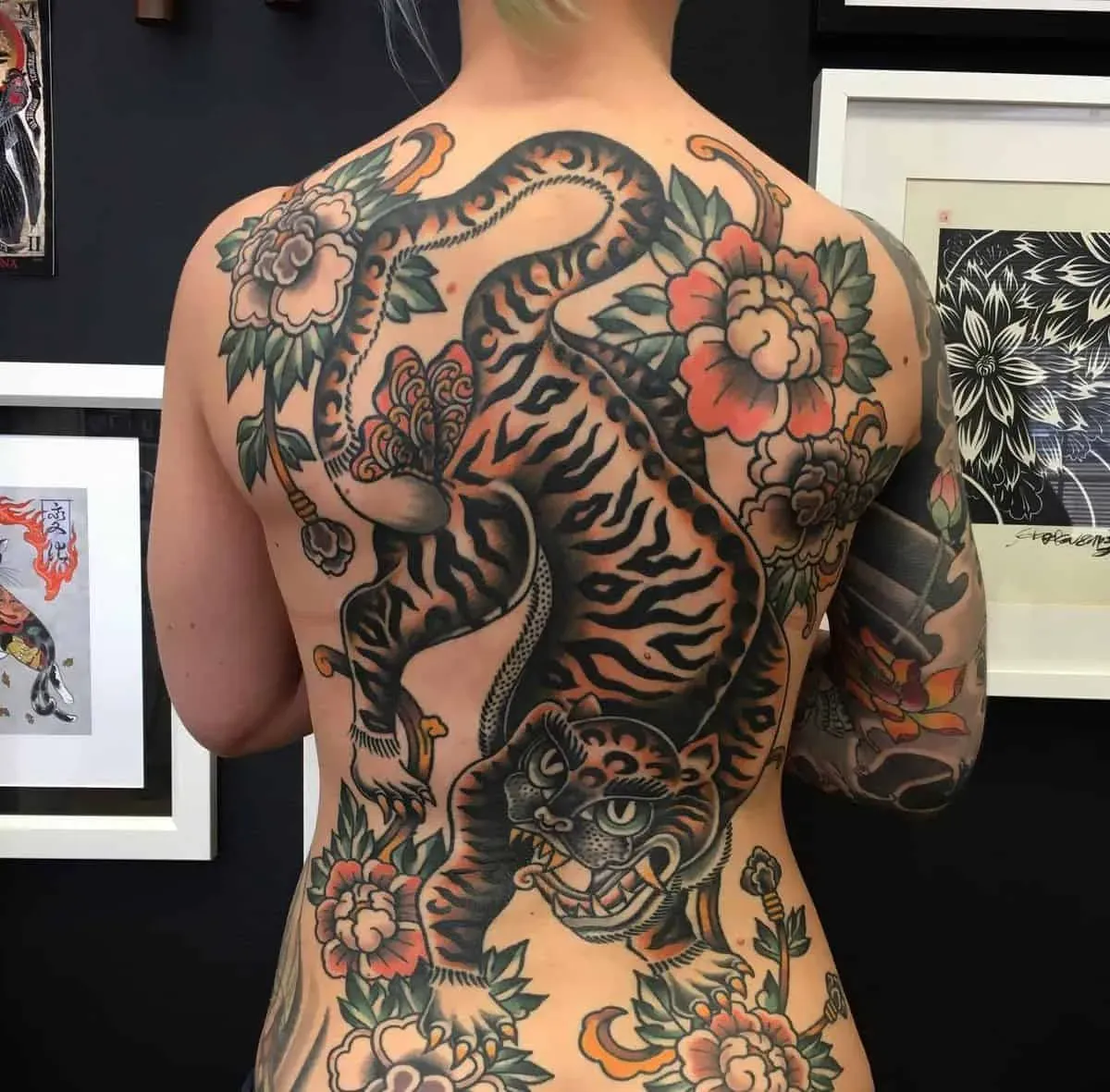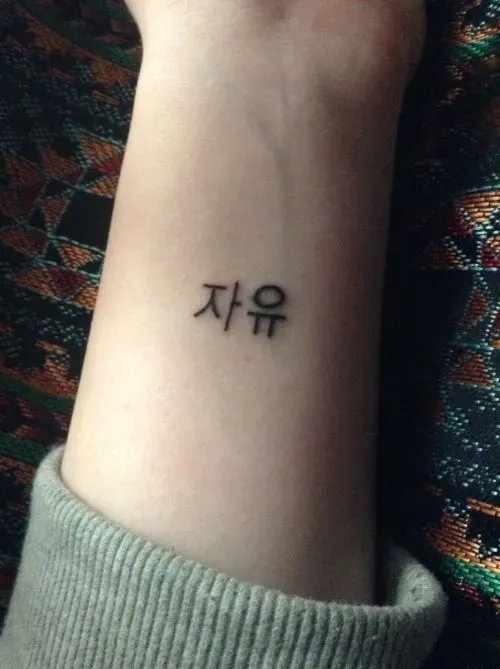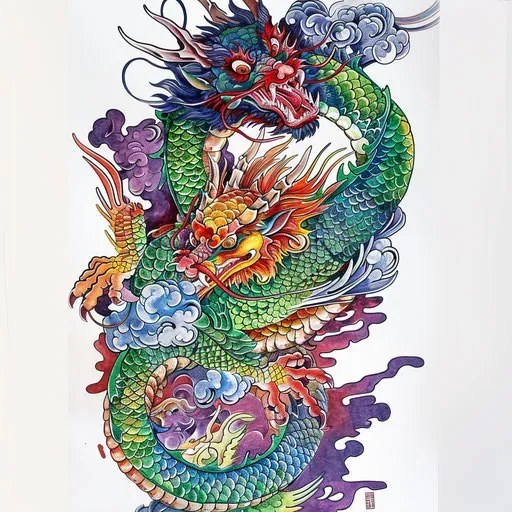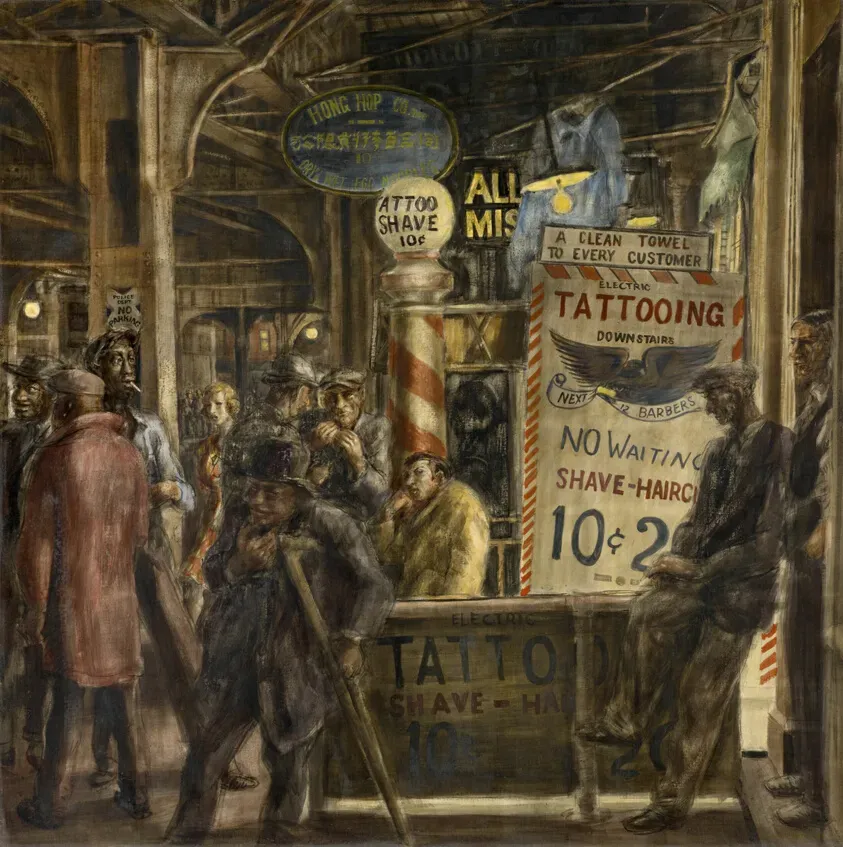Table of Contents
Thinking about getting inked? Maybe you've scrolled through endless feeds and noticed something different, something subtle yet striking. That's often the magic of korean tattoo designs. Forget the old-school, heavy-handed approach; modern Korean artists have carved out a unique space in the tattoo world, known for their delicate lines, vibrant watercolors, and deeply personal motifs.
Understanding Korean Tattoo Designs: More Than Just Ink
Understanding Korean Tattoo Designs: More Than Just Ink
Beyond the Bold Lines: A Delicate Approach
When you look at korean tattoo designs, you're often seeing a departure from the traditional Western or even Japanese styles. Think less heavy blackwork, fewer massive, sprawling pieces covering entire limbs. Instead, many contemporary Korean artists favor fine lines, subtle shading, and delicate color palettes. It's an aesthetic that feels more like a watercolor painting or a fine illustration etched onto the skin, rather than a thick, impenetrable block of ink.
This isn't an accident. It reflects a different perspective on body art. It's about subtlety, about designs that complement the body rather than dominating it. Many pieces are small, placed on wrists, ankles, or behind the ear. They feel intimate, personal, almost like a secret whispered on the skin. It’s a quiet confidence in design.
A Shifting Cultural Canvas: From Stigma to Artistry
Historically, tattoos in Korea carried a significant stigma, often associated with organized crime or undesirable elements of society. Getting inked wasn't something you'd openly discuss at the dinner table. This deep-seated societal view took a long time to shift. But over the past couple of decades, there's been a significant cultural transformation, largely driven by younger generations and incredibly talented artists who pushed boundaries.
These artists, many operating in underground or appointment-only studios in places like Seoul, started experimenting. They weren back to traditional Korean art forms, nature, and everyday objects, translating them into a fresh, minimalist language of ink. They essentially rebranded tattoos from something illicit to something beautiful, personal, and worthy of artistic merit. This evolution wasn't easy; it required challenging long-held beliefs.
Comparing Traditional vs. Modern Korean Tattoo Vibes
- Traditional Association: Often linked to gangs, rebellion.
- Modern Association: Seen as personal expression, art form, fashion.
- Design Style (Traditional): Scarification, sometimes basic symbols (though less documented than other cultures).
- Design Style (Modern): Fine line, minimalist, watercolor, small-scale, nature motifs, abstract.
- Visibility: Traditionally hidden; modern pieces often visible but subtle.
The Philosophy of Understated Beauty
So why this focus on the delicate and the small? Part of it ties into that historical stigma – smaller, less obvious tattoos were easier to conceal. But it’s also a conscious artistic choice that resonates deeply with a modern Korean aesthetic that values elegance and subtlety. Think about Korean fashion, design, or even their approach to beauty – there's often an emphasis on natural enhancement rather than dramatic alteration.
Korean tattoo designs often embody this philosophy. They aren't screaming for attention; they invite a closer look. A tiny flower on a finger, a single line drawing of a cat, a splash of soft color that looks painted on – these aren't meant to shock, but to charm and intrigue. It’s art that feels like a part of you, not just stuck onto you. It’s about finding beauty in the simple, the ephemeral, and the personal.
Popular Styles and Trends in Korean Tattoo Designs
Popular Styles and Trends in Korean Tattoo Designs
Fine Line and Minimalist Masterpieces
When people talk about modern korean tattoo designs, they're often picturing the fine line and minimalist styles. Think incredibly thin lines, sometimes single-needle work, creating delicate outlines of objects, animals, or abstract shapes. These aren't meant to be loud; they are subtle, almost like a whispered secret on the skin.
Artists have perfected the technique of using minimal ink to create maximum impact. A tiny constellation on a wrist, a single stem rose on an ankle, or a simple geometric pattern – these are hallmarks of this trend. It’s about negative space and precision, making the ink feel integrated with the body rather than just sitting on top of it. My first small piece, a tiny wave on my finger, was done in this style by a Korean artist, and the detail in such a small space was honestly mind-blowing.
Watercolor and Color Pop
Another hugely popular trend in korean tattoo designs is the use of soft, diffused color, often mimicking watercolor paintings. Instead of harsh outlines and solid blocks of color, artists blend pigments seamlessly, creating ethereal washes of color that look incredibly organic and fluid. It's a stark contrast to the fine line style, yet often pairs beautifully with it.
You'll see splashes of vibrant blues, pinks, and purples used to fill in floral designs, abstract shapes, or even simple silhouettes. It requires a steady hand and a deep understanding of color theory to make sure the colors heal well and retain their soft, blended look. These designs often feel whimsical and painterly, bringing a different kind of artistic expression to the skin.
Popular Korean Tattoo Styles: A Quick Look
- Fine Line: Ultra-thin lines, detailed, often small.
- Minimalist: Simple shapes, outlines, focus on negative space.
- Watercolor: Soft, blended color washes, no harsh outlines.
- Botanical/Floral: Delicate depictions of flowers, leaves, nature.
- Pet Portraits: Realistic or stylized small tattoos of pets.
- Abstract Shapes: Geometric patterns, fluid lines, non-representational art.
The Meaning Behind Common Korean Tattoo Designs
The Meaning Behind Common Korean Tattoo Designs
Symbolism That Whispers, Not Shouts
Unlike some tattoo traditions where symbols have rigid, centuries-old definitions, the meaning behind korean tattoo designs often leans towards the personal and the contemporary. While there are certainly cultural touchstones and traditional images, modern artists and clients frequently imbue designs with individual significance. A design that might traditionally represent longevity could, for a client, simply remind them of a cherished grandparent.
It's less about adhering to a strict lexicon and more about finding an image that resonates with your own story or feeling. This flexibility is part of what makes the style so appealing; you're not just getting a picture, you're getting a piece of art that holds meaning specifically for you. Think of it as a visual diary entry, rather than a history textbook illustration.
Some Common Motifs and Their General Associations:
- Flowers (like Mugunghwa, Peony, Plum Blossom): Often symbolize beauty, prosperity, perseverance, or specific seasons.
- Animals (like Tigers, Cranes, Koi Fish): Can represent strength, longevity, good fortune, or personal attributes.
- Nature Scenes (Mountains, Waves, Trees): Connect to harmony, resilience, or the flow of life.
- Hangeul (Korean Alphabet): Personal names, meaningful words, dates, or phrases.
- Geometric Shapes: Can represent balance, structure, or abstract concepts.
Decoding Popular Images in Korean Ink
Let's look at a few specific examples you'll see popping up in korean tattoo designs. Flowers are huge, for instance. The Mugunghwa, or Rose of Sharon, is Korea's national flower, symbolizing perseverance and resilience – pretty heavy stuff for a delicate bloom. Peonies often show up too, traditionally linked to wealth, honor, and prosperity. But maybe you just love the way a specific flower looks, and that's a perfectly valid reason to get it tattooed, too. The artist can capture its beauty in that signature fine-line or watercolor style, regardless of deep historical meaning.
Animals also play a role. Tigers have historically been important figures in Korean folklore, representing power and protection. Cranes are symbols of longevity and peace. Even something as simple as a tiny cat outline can hold immense meaning for a pet owner. It's about finding that visual hook that connects with something real in your life.
Your Story, Your Design
Ultimately, the most compelling meaning in korean tattoo designs comes from you. A talented artist isn't just a technician; they're a collaborator. They'll listen to your ideas, your personal history, and the feelings you want to evoke. They can take a simple concept – like missing home – and translate it into a subtle design, maybe a specific flower from your hometown or a tiny outline of a significant landmark, rendered with their unique artistic touch.
Don't feel pressured to pick a design solely based on a generic symbolic meaning found online. The best korean tattoo designs are those that are deeply personal. Talk to your artist about why a certain image or idea resonates with you. That conversation is where the true meaning is forged, resulting in a piece of art that is not only beautiful but also uniquely yours.
What memory or feeling would you want to capture in a small, subtle design?
Finding the Right Artist for Your Korean Tattoo Designs
Finding the Right Artist for Your Korean Tattoo Designs
Searching Beyond the Local Shop
Finding an artist who specializes in the kind of delicate, fine-line, or watercolor work often seen in korean tattoo designs requires looking specifically for those skills. You're probably not going to find these artists by just walking into the nearest street shop. Most highly sought-after artists, especially those influenced by the Korean style, primarily showcase their work on platforms like Instagram. This is your visual catalog.
Spend time scrolling. Look at their healed work, not just fresh photos. See if their lines are consistently clean, if their color blends smoothly, and if their overall aesthetic matches what you envision for your korean tattoo designs. Pay attention to where they're located – many top artists are in major cities, and travel might be necessary. Don't settle for someone who just *says* they can do the style; their portfolio needs to prove it.
Booking a Consultation and Trusting Your Gut
Once you've narrowed down a few potential artists whose portfolios impress you, the next crucial step is a consultation. This can be in person or sometimes online, depending on the artist. This meeting isn't just for them to see your idea; it's for you to gauge their communication style, their understanding of your vision, and whether you feel comfortable with them. A good artist specializing in korean tattoo designs will listen intently to your concept and offer their professional input on placement, size, and how the design will age.
Ask questions about their process, their experience with this specific style, and aftercare. Pay attention to how they respond. Do they seem rushed or genuinely engaged? Are they explaining things clearly? This person is about to put permanent art on your body. Trust your intuition. If something feels off, or if they try to push you into a design you're not 100% sold on, it's okay to walk away and find someone else. Your comfort and confidence in the artist are just as vital as their technical skill.
Questions to Ask During a Consultation:
- How long have you been tattooing in this specific style (fine line, watercolor, etc.)?
- Can I see healed examples of your work in this style?
- What is your process for designing the piece based on my idea?
- What are your recommendations for placement and size to ensure the design ages well?
- What is your typical aftercare process and recommendation?
- What is your cancellation or rescheduling policy?
Caring for and Living with Your Korean Tattoo Designs
Caring for and Living with Your Korean Tattoo Designs
The Crucial First Few Weeks: Healing Your Delicate Ink
you've got your beautiful new piece of korean tattoo designs. Now comes the part that's less glamorous than picking the art: healing it properly. This isn't the time to be lazy. Those fine lines and soft colors are delicate, and how you treat them in the first couple of weeks makes a massive difference in how they'll look for years. Your artist will give you specific instructions, and you should follow them to the letter, even if your friend with the tribal armband tells you differently. Usually, it involves keeping it clean with mild soap and water, applying a thin layer of recommended ointment or lotion, and keeping it out of direct sunlight.
Forget soaking it in the bath or hitting the gym for intense sweaty sessions right away. Friction and moisture are not your friends during this critical period. You want to protect that fresh ink like it's a priceless miniature painting (which, in a way, it is). Peeling and itching are normal, but picking is strictly forbidden unless you want patchy, scarred results. Think of it as a temporary, slightly uncomfortable phase for a lifetime of cool.
Living with Your Art: Long-Term Care for Korean Tattoo Designs
Once your korean tattoo designs are fully healed, the daily drama is over, but the need for care isn't. Fine line and watercolor tattoos, while stunning, can be more susceptible to fading over time compared to bold, black work. The sun is the number one enemy. Seriously, treat your tattooed skin like a vampire treats daylight. Always, always use a high SPF sunscreen on your tattoos, even on cloudy days. This is non-negotiable if you want those delicate details and colors to stay crisp.
Keeping your skin generally healthy and moisturized also helps. Hydrated skin looks better, and your ink will look better on it. Think of it as preserving the canvas. Touch-ups might be necessary down the line, especially for ultra-fine lines or vibrant colors on high-friction areas like fingers or wrists. It's not a failure of the artist or the tattoo; it's just the nature of ink in skin. Budget for potential touch-ups, and go back to your original artist if possible, as they know their own work best.
Long-Term Tattoo Care Essentials:
- Sunscreen: SPF 30 or higher, applied regularly when exposed to sun.
- Moisturize: Keep skin hydrated daily.
- Avoid Harsh Chemicals: Be mindful of strong soaps or exfoliants directly on the tattoo.
- Stay Hydrated: Drinking enough water benefits skin health overall.
- Consider Touch-Ups: Plan for potential touch-ups over the years, especially for fine-line or color work.
Your Korean Ink Journey
So, we’ve covered the landscape of korean tattoo designs, from the subtle lines and watercolor washes to the deeper meanings often tucked within these visual stories. You've got a better handle on what makes this style distinct, a few ideas on common motifs, and hopefully, a clearer path toward finding an artist who can execute your vision. Getting a tattoo is a permanent decision, obviously, and choosing a Korean style means paying attention to nuance and detail. Do your homework, pick your artist wisely, and understand that the real art isn't just the design itself, but how it becomes a part of your story.